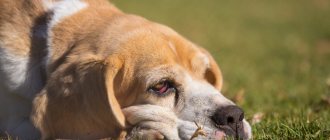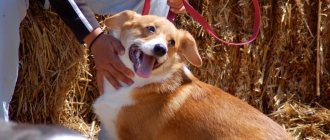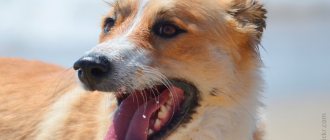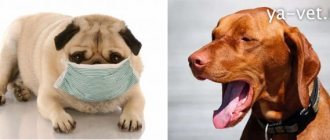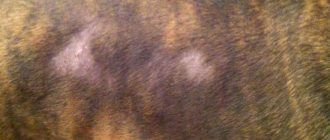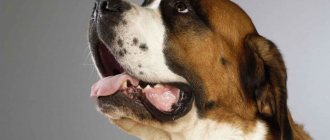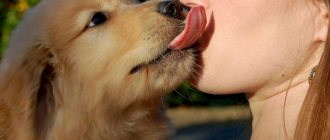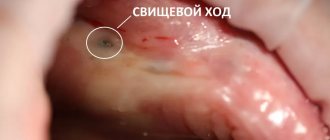Often, a dog owner notices that his pet is “crying.” Flowing tears leave wet marks on the animal's face and color the corners of the eyes brownish or reddish.
Why do my dog's eyes water? Most often this is due to the breed characteristics of the animal or foreign particles getting into the eyes, but sometimes the problem can be more serious and require the help of a veterinarian.
Content
1. Pathology or cosmetic defect? 2. What causes tear tracks to appear 3. Should I treat or wash it off? 4. How to remove tear tracks 5. Should you use folk remedies? 6. Prevention of tear ducts 7. Diagnosis and treatment
Some dogs have unsightly reddish and brown spots on their faces, which are especially noticeable in light-colored dogs. These are tear tracks that cause a lot of grief to owners, but not everyone knows that the reason for their appearance can be serious.
Breed characteristics
In the huge family of canines, there are dog breeds for which teary eyes are a completely normal phenomenon. Brachycephals with a flattened muzzle, long-haired individuals, and those with a large palpebral fissure walk with perpetually wet eyes. Discharge from the eyes is considered normal for them and does not require special treatment, just competent care. The list of breeds includes:
- Saint Bernard;
- bulldogs;
- Bloodhound and Basset;
- chow-chow;
- Cocker Spaniel;
- many decorative breeds (Yorkies, Pekingese);
- Shar Pei;
- bullmastiff;
- Great Danes.
Pathology or cosmetic defect?
Veterinary medicine has a separate branch - veterinary ophthalmology. And pathologies of the lacrimal drainage system in it are the most common. Frequent patients of veterinary clinics are dogs of dwarf breeds - toy poodles, Yorkshire terriers, bichons, papillons, dwarf dachshunds and others. Dry eyes and brown or reddish colored tear tracks are clearly visible on the light fur of the muzzle. Foreign experts have come up with a special term for the pathology - “tear staining syndrome.”
Tear tracks are pigmented areas of fur that are moistened by tears. The tear fluid contains substances that oxidize, which forms the brown color. The lacrimation can be so severe, for example, when the tear duct is completely blocked, that tears drip onto the floor. If tear tracks are not removed, constantly wet skin will become inflamed, and weeping eczema may occur.
What symptoms should you go to the vet for?
We looked at the different causes of tearing. Some of them the dog owner can successfully cope with at home. A mandatory visit to a doctor is necessary if:
- the discharge acquires the structure of purulent exudate;
- the pet's eyes turn red;
- the eyelids are very swollen;
- photophobia appears;
- the lens of the eye becomes white;
- the dog has no appetite, its behavior becomes lethargic;
- the color of the fur around the eyes changes;
- a film appears on the eyeball.
What causes tear tracks to appear
The problem goes beyond aesthetics, although it is primarily the pet’s appearance that deteriorates. There is no dependence on the breed; representatives of different breeds, mostly light or white in color, suffer from constant lacrimation.
There may be several reasons. Epiphora (lacrimation) can be unilateral or bilateral, abundant or minor, congenital or developed at some point in life. The reasons may be related to both increased tear production (irritation) and its outflow. The third type, the most common, is idiopathic lacrimation.
Veterinarians identify several causes of dysfunction of the lacrimal system:
- obstruction of the lacrimal canaliculi, which becomes a consequence of the accumulation of mucus and pathogenic bacteria in them, which provokes the development of the inflammatory process. It is extremely rare, but in veterinary practice there are cases of chemical and thermal burns that led to pathology;
- atresia (fusion) of one or both lacrimal openings - genetic (congenital) or acquired pathology. In dogs, it is typical for some breeds - poodles, American cocker spaniels, Samoyeds, golden retrievers, Bedlington terriers. In them, infection of the lower lacrimal punctum is more common, but if both are absent, epiphora develops;
- obstruction of the nasal part of the nasolacrimal duct (stenosis). Pathology can be caused by viral and bacterial conjunctivitis, injuries to the lacrimal drainage system, as well as congenital defects - the absence or anatomical narrowness of certain sections of the nasolacrimal ducts, breed predisposition;
- shallow tear lake - a pathology characteristic of some breeds of dogs of the brachycephalic type (pugs, boxers, bulldogs, etc.);
- Dacryocystitis is inflammation of the lacrimal sac, more often unilateral. It may be a consequence of viral herpes, a foreign body, an inflammatory process or a tumor.
Increased lacrimation can be triggered by an allergic reaction of the animal’s body, more often to food. Therefore, veterinarians recommend that you be very careful when choosing food for pets with white or light hair. If there is a need to change the diet, you cannot do it suddenly - the transition should be gradual so that digestive problems do not arise.
Other causes of increased lacrimation include the following, which are not obvious but possible:
- ear infections;
- oral infections;
- change of teeth, etc.
Sometimes diseases of the nasal cavity lead to compression of the nasolacrimal duct. In each specific case, only a veterinarian is able to determine what caused epiphora, especially if the disease developed during the pet’s life.
Lacrimation associated with excessive tear production: causes, treatment
Much more often, excessive tearing is caused by increased tear production.
Breed characteristics
Often found in dogs with round, wide-open eyes and/or lots of fur around the eyes. Constant irritation of the cornea by dust particles and hairs provokes increased production of tears, which should quickly wash away foreign objects. It is very important for owners to keep these eyes clean and regularly remove excess moisture from the corners and tear ducts with a gauze swab dipped in lotion. And also prevent hair from getting on the cornea.
Entropion and eversion of eyelids
In the first case, the eyelashes of the upper or lower eyelid are adjacent to the cornea and constantly irritate it. Hereditary predisposition is noted in many breeds: Shar Pei, Chow Chow, Alabai, Caucasian Shepherd, Akita, Cane Corso, AST, Bulldog, Pekingese, Spitz, Pug, York, Bull Terrier, Dalmatian, Rottweiler, Husky, Great Dane, Poodle and others. Eversion is the formation of excess space between the lower eyelid and the eye. The eyelid droops downwards or to the side. More common in basset hounds, bulldogs, bull terriers, cocker spaniels, Labrador retrievers, and Shih Tzus. It is very rare that these two pathologies are observed simultaneously in giant breed dogs.
Cunning breeders often sell puppies with such defects, convincing buyers that they are cosmetic. But without surgical intervention, any of them will lead to decreased or complete loss of vision.
Distichiasis
Pathological eyelashes sometimes grow on a dog’s eyelids, which “lie” on the cornea. The disease is called districhiasis. It is hereditary, the average age of manifestation is 3 years. Spaniels, Bulldogs, Shelties, Shih Tzus, Dachshunds, Poodles, Pekingese and others are predisposed.
There are three treatment methods. Epilation brings only short-term results. Surgical excision of “irregular” hair follicles is dangerous due to the formation of scars, which will further injure the cornea. Cryo-epilation is considered the most gentle option, but is carried out in few clinics.
Districhiasis in a dog. An eyelash growing downward irritates the cornea, causing constant tearing.
Injuries, irritation
Excessive lacrimation that appears suddenly can be the result of injury, dust, a foreign object, or your own fur getting into the eyes. This can often be observed after walking, running through the bushes, on the beach or in tall grass. Watery eyes usually occur in one eye.
Allergy
Watery eyes from one or both eyes can be caused by allergies to food, air freshener, cosmetics, a new bed, cigarette smoke and much, much more. The eyes can be the site of development of an allergic reaction in many systemic immunological disorders: rhinitis, asthma, atopic dermatitis. And also in case of systemic interaction with the toxin when affected by worms or external parasites. The veterinarian will prescribe anti-allergy medications that block the action of histamine, in addition to eye drops.
Infections
If your dog has gassy tears, this may be a symptom of a local or general infection caused by a virus, bacteria, or fungi. For example, epiphora occurs against the background of conjunctivitis and other ophthalmological diseases, acute viral infection (aviary cough, plague, enteritis), food poisoning, pneumonia, etc. Often, lacrimation accompanies otitis media and various diseases of the oral cavity.
Diet
Watery eyes may indicate a lack of nutrients, in particular vitamin A, B1, B6, and lutein. This happens when a dog eats economy-class food or table scraps for a long time. Improving the menu and introducing vitamin complexes can significantly improve the condition of the pet and his eyes.
What to do
First of all, you need to thoroughly wash your hands and carefully examine the dog's eyes. If the cause of lacrimation is a foreign object (fur, dust, lint), it must be carefully washed off with hygienic eye lotion (diamond eyes, Apicenna Dewdrop, Veda and Calendula/Chamomile) or clean boiled water, heated to a temperature of 40°C. If there is inflammation (redness of the conjunctiva), apply anti-inflammatory antibacterial drops. This can be regular albucid (sulfacyl) or chloramphenicol eye drops.
If no visible cause of lacrimation is found, the pet’s eyes should be cleaned and the area wiped dry. Treat with hygienic lotion or apply anti-inflammatory drops to prevent infection.
You also need to analyze the parameters of keeping and feeding dogs. If an animal lives outside in damp conditions and tries to unbalance its immune system, it weakens and various diseases develop, one of the symptoms of which may be lacrimation. The eyes of pets living in an apartment may encounter various irritants, which are mentioned above. And as long as they affect the cornea, treatment of epiphora will be ineffective.
If you suspect a corneal injury, you should immediately contact the clinic. If possible, apply a bandage and do not allow the dog to rub its face with its paws.
Treatment
Therapy is aimed at eliminating the cause of epiphora. In the initial stages of viral or bacterial conjunctivitis, when foreign bodies, liquid or gaseous irritants enter, veterinarians often recommend the drug diamond eyes, ophthalmosan or similar (bactericidal and anti-inflammatory drops with chlorhexidine and succinic acid, used for the prevention and treatment of acute and chronic ophthalmological diseases, hygienic eye treatment for age-related degenerative and dystrophic diseases of the retina and cornea).
In advanced cases, in the presence of a bacterial infection, stronger antibiotic-based agents are used: iris, dekta-2, ciprolet, leopard, chloramphenicol drops, sofradex, gramicidin, tobrex, erythromycin or tetracycline eye ointment.
If lacrimation is a symptom of a disease in other organs or systems, the treatment regimen will include eye drops or ointments that will help prevent the development of serious ophthalmological diseases.
How to remove tear tracks
Eye hygiene is an important procedure that needs to be paid attention to daily. A humid environment is a favorable place for the proliferation of pathogens that can cause serious infectious diseases in animals.
For hygiene procedures, you can choose special products:
- lotions, for example, Excel Tear Stain Remover Liquid, Beaphar Sensitiv, Doctor Vic and others;
- drops – Beaphar Oftal, Espree to remove stains from fur and around the eyes AC Tear Stain & Spot Remover, etc.;
- products for removing marks and whitening wool - Transgroom Show Tech Tear Stains Remover, ESPREE Tear Stain & Spot Remover, Bio-Groom Stain Free and others.
You can buy them at a pet store or veterinary pharmacy. A veterinarian will help you choose the most effective one, taking into account your coat type and color.
Treatment regimen and drugs
Below we provide an approximate treatment regimen and drugs used in the treatment of ophthalmic pathologies. Please note that before starting treatment you should definitely consult a veterinarian!
- The veterinarian conducts a thorough examination and decides how to treat. Thus, entropion of the eyelids or corneal ulcers are treated surgically, while conjunctivitis can be treated with medication.
- Almost always, rinsing the conjunctival cavity with antiseptic solutions is prescribed.
- Also, ointments with an antiseptic and antibacterial effect (like tetracycline) are placed in the conjunctival cavity.
- The crusts of dried exudate around the eyes are regularly removed, and excess hair is cut off.
- As a rule, the pet is prescribed antibiotics or other antibacterial medications.
In many cases, the following drugs are used:
- 1% tetracycline ointment.
- 1% hydrogen peroxide used to wash the conjunctival cavity and skin around the eyes. For the same purposes, a very weak solution of potassium permanganate or furatsilin can be used.
- Painkillers and sedatives (at least analgin) are prescribed.
- Pilocarpine to reduce intraocular pressure.
- Antibiotics from the cephalosporin group.
- Anti-inflammatory corticosteroids are used to relieve inflammation.
Prevention of tear tracks
If the cause of epiphora is not genetic pathologies, you can try to reduce lacrimation and its unsightly cosmetic consequences. To do this you need:
- periodically examine the dog's eyes; any signs of ill health - redness, inflammation, swelling, etc. - are a reason to contact a veterinarian. If a dog hides from the light, often closes its eyes, rubs its muzzle with its paws, or scratches itself on its bedding, these are “bells” indicating that it is time to see a doctor;
- Regularly clean your eyes from dirt and dust using special wipes and lotions. For wiping, choose only sterile gauze wipes; cotton wool can leave lint that gets into the eye, causing even more inflammation. You can wash your eyes with chamomile decoction, and tea (infusion) will leave dark marks on the white or light fur of the muzzle;
- Use shampoo and other detergents carefully when bathing your dog: if they come into contact with the eyes, they should be rinsed immediately with water.
Whitening shampoos for dogs
Most dog coat bleaching shampoos contain a bluing agent , which gives white fur a blue tint that is perceived as white by the human eye. The optical illusion is achieved due to the fact that the blue or purple color coloring the ends of the hair reflects light, and the coat appears lighter, whiter. But the white effect is achieved only in the presence of faint yellow spots. After using a bluing agent, it is necessary to wash it again with regular shampoo so that the coat does not acquire a concentrated blue color. You cannot use several whitening shampoos at the same time. For example, using a bluing shampoo after a bleaching shampoo can cause your hair to turn blue.
Enzyme-based lightening shampoos remove yellow stains from saliva and tears, allowing you to achieve the desired result. But the product acts harshly, removing the outer layer of each hair. Therefore, it is not recommended to use enzymatic shampoos frequently. It is usually used with a good conditioner that has a restorative effect.
Whitening shampoos for dogs contain aggressive chemicals that help achieve whiteness, but if used incorrectly can cause dry, irritated skin. Such aggressive substances include hydrogen peroxide, which increases the pH level, thereby bleaching hair.
The effect of all shampoos is enhanced by using warm water, which promotes deeper cleansing of impurities from the hair. But it is better to rinse off the shampoo with cool water, which helps close the hair scales. The active ingredients are fixed inside the hair, after drying, maximum reflection of light occurs, achieving the effect of whiteness and radiance. Beaphar, 8in1, Mr. cosmetics work well. Bruno, Espree, All Systems, Chris Christensen.
Corneal ulcers
These can be superficial or deep ulcers, which can be painful. They can be caused by injury to the cornea, illness, lack of tears, a foreign object in the eye, and other injuries.
Corneal ulcers cause red and watery eyes, light sensitivity, squinting, paw rubbing, a film on the eye, and discharge.
Treatment may require surgery, antibiotics, or anti-inflammatory drugs. Seek medical attention for your pet immediately.
Epiphora (excessive tearing)
Watery eyes and watery eyes, resulting in stained or smelly fur and/or infected skin, can also be the result of many conditions, including abnormal eyelashes, inflammation, allergies, corneal ulcers, tumors, eye pain and more.
Treatment for excessive tearing depends on what is causing it and may include: topical antibiotics or steroids for inflamed tear ducts; antibiotics and medications for topical use for corneal damage; or surgery for blocked ducts, ulcers, or abnormal eyelashes.
Conjunctivitis
Mucus, yellow-green pus, or watery discharge may be signs of conjunctivitis, an inflammation of the lining of your dog's eye. There is a wide range of causes for conjunctivitis, from allergies, injuries, birth defects and tear duct problems to foreign bodies, dry eyes, plague or even tumors.
Other signs of conjunctivitis include very red eyes, inflammation, excessive blinking, squinting, crusty eyes, scratching with paws, or closing of the eyelids.
To treat conjunctivitis, it is important to know what causes it.
Depending on the cause, treatment may include: removing the irritant and soothing the area with pain medication; antibiotics and saline solutions to fight infection; surgery to treat duct disease or birth defects; antihistamines for allergies; or other medications.
Diagnostics
Lacrimation must be differentiated from tears or purulent exudate.
A study is being conducted with a silver-based drug. If everything is in order, then it appears in the nostrils 10 seconds after entering the eyes. This experiment will provide information about the location of the blockage. In this case, the drug is instilled into the upper lacrimal punctum. When the substance does not come out of the lower one, a blockage of the upper or lower tubule, a blockage in the sac, should be diagnosed, sometimes this is due to the anatomical absence of the lacrimal punctum.
If there is an anomaly in the structure of the nose or its sinuses, a rhinoscopy is performed with a biopsy of all strange parts; the exudate can be collected for microbial analysis. If the exudate is pus, then a microbial analysis must be done before prescribing therapy.
An x-ray will provide some information. In particular, damage to the bones of the nose, sinuses, and upper jaw can be established.
Dry eye
Sticky, viscous discharge may indicate this disease in dogs—an inability to produce enough cleansing tears. Dry eye—symptoms can also include mucus and inflammation—can be the result of plague, injury, a blow to the head near the tear gland, or the body's own immune system attacking tear gland tissue.
The infection poses a serious risk for dogs with dry eye and can lead to painful inflammation in the eyes.
Ulcers on the cornea (surface of the eye) also pose a serious risk because without the lubricating effect of tears, the eyelid can scratch the surface of the cornea simply by opening and closing the eye.
Treatment for this condition depends on its severity and may include artificial tears for several weeks for mild dry eye; antibiotic eye drops to treat secondary infections; immunosuppressants, which help control the immune system; or surgery.

